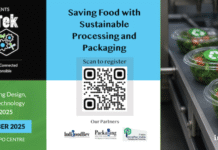
Sriman Banerjee is head of diagnostics, Software Devices & Packaging, and R&D Pharma Science, at the R&D-driven global biopharmaceutical major Takeda. With roots in Japan, the US$ 30 billion company is present across 80 countries with a major presence in the US, Europe, Canada, Japan, and other emerging markets. Based in the United States, Banerjee is the son of the late pioneer in plastic rigid packaging in India, Onkar Banerjee.
Banerjee is actively involved in Takeda’s environmental sustainability goals – partnering with suppliers to develop new materials, new printing and manufacturing processes, as well as recycling materials in packaging. He was recently in Bangkok to accept a WorldStar award in the medical and pharmaceutical category for Takeda Pharma and Aptar’s Instanyl DoseGuard Nasal Spray Devices.
The world is moving toward sustainable solutions in all economic sectors and packaging is not to be left behind. The packaging sector is also looking at, exploring, and implementing eco-friendly solutions to minimize the use of plastic. We recently asked Banerjee how he looked at the problem and the possible solutions as far as packaging and its role in the circular economy as well as the challenges it presents for product design in stringently regulated industries such as pharma.

According to Banerjee, there are two environmental sustainability aspects to packaging – carbon footprint and waste management and/or recycling. “The industry is balancing both aspects and moving more towards a circular economy by using a mix of materials, formats, manufacturing, and end-of-life solutions.”
Apart from reducing plastic use, how can the industry reduce its overall carbon footprint, such as the sensible use of water, power, inks, and chemicals? Banerjee says sustainability is not limited to material, format, or processing but is holistic. “However, we need to understand and find the right balance. The supply chain also plays an important role, including sourcing and manufacturing. Most companies are leveraging sustainable energy sources, water harvesting, and recycling to the extent possible and limiting the use of inks and chemicals. An example would be digital printing, the CMYK color palette, and so forth.”
As biodegradable and compostable packaging, renewable materials, and biopolymers have become buzzwords with many companies claiming such solutions, we ask about their feasibility in the long term as well as their cost-effectiveness. Banerjee explains that multiple aspects of feasibility, availability, manufacturing, costs, and sustainability are involved. For instance, most novel solutions currently have limited availability, which restricts their application. When availability increases, the industry will adopt these solutions.
The discussion shifts to packaging recycling and the circular economy, especially in the pharma and food industries. Banerjee sees an urgent need to overcome the thought process of downcycling. “Moreover, many packaging materials and formats used today are recycled laterally and used for the same application. Recycled PET is a good example where it is used for beverage bottles. There are similar examples of using recycled paper for secondary and tertiary packaging,” he said.
Multi-layer plastics in packaging are seen as a problem with many players moving toward mono-materials, while others are focusing on paperization to address this issue. Banerjee, however, feels all materials and formats have their application. “Innovation and evolution are a continuous process. At times, simplification into mono materials may be a good way forward.”

Speaking about the pharma industry confronting the sustainability challenge, he says while pharma companies are evaluating several alternatives, in Japan an interesting approach is biopolyethelene blisters. A consortium of four companies – Takeda, Astellas Pharma, Daiichi Sankyo and Eisai is collaboratively working on this development.
Takeda’s recent WorldStar award was for a nasal spray device – the innovation of an electromechanical device and packaging for a drug product in a specific therapeutic area. Banerjee, who was present in Bangkok to receive the award, says it addresses the safety requirements for patients using a drug in that therapy. He says packaging design in the pharma industry is directed towards providing patient-centricity, dosage adherence, safety, and regulatory considerations. The new-age drugs of cell, gene and similar therapies have specific needs that are being addressed with a mix of design and technology, leveraging science.
We ask how he envisages the future of the packaging industry in a country like India where there is a surging demand for hygienically packed products after the global Covid pandemic but where the per capita consumption of packaging seems low. According to Banerjee, for the part of the population with a similar range of per capita income as the West, the packaging consumption is similar. “However, emerging economies have a substantial population that has a low per capita income and that skews the consumption numbers. As more sections of the population increase their per capita, the lifestyle evolves and so does the use of packaged products.”










